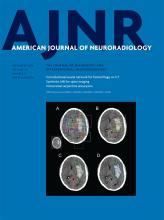Research ArticleFunctional
Breath-Hold Blood Oxygen Level–Dependent MRI: A Tool for the Assessment of Cerebrovascular Reserve in Children with Moyamoya Disease
N. Dlamini, P. Shah-Basak, J. Leung, F. Kirkham, M. Shroff, A. Kassner, A. Robertson, P. Dirks, R. Westmacott, G. deVeber and W. Logan
American Journal of Neuroradiology September 2018, 39 (9) 1717-1723; DOI: https://doi.org/10.3174/ajnr.A5739
N. Dlamini
aFrom the Division of Neurology (N.D., G.d.V., W.L.)
bNeurosciences and Mental Health Program (N.D.)
cChild Health Evaluative Sciences Program (N.D., A.R., G.d.V.)
hInstitute of Medical Science (N.D., G.d.V.)
kDevelopmental Neurosciences (N.D., F.K.), University College London, Great Ormond Street Institute of Child Health, London, UK.
P. Shah-Basak
eDiagnostic Imaging (P.S.-B., M.S.)
jRotman Research Institute (P.S.-B.), Baycrest, Toronto, Ontario, Canada
J. Leung
dTranslational Medicine (J.L., A.K.)
F. Kirkham
kDevelopmental Neurosciences (N.D., F.K.), University College London, Great Ormond Street Institute of Child Health, London, UK.
M. Shroff
eDiagnostic Imaging (P.S.-B., M.S.)
A. Kassner
dTranslational Medicine (J.L., A.K.)
iDepartment of Medical Imaging (A.K.), University of Toronto, Toronto, Ontario, Canada
A. Robertson
cChild Health Evaluative Sciences Program (N.D., A.R., G.d.V.)
P. Dirks
fDepartment of Neurosurgery (P.D.)
R. Westmacott
gDepartment of Neuropsychology (R.W.), The Hospital for Sick Children, Toronto, Ontario, Canada
G. deVeber
aFrom the Division of Neurology (N.D., G.d.V., W.L.)
cChild Health Evaluative Sciences Program (N.D., A.R., G.d.V.)
hInstitute of Medical Science (N.D., G.d.V.)
W. Logan
aFrom the Division of Neurology (N.D., G.d.V., W.L.)

References
- 1.↵
- Lynch JK,
- Hirtz DG,
- DeVeber G, et al
- 2.↵
- Fullerton HJ,
- Wu YW,
- Zhao S, et al
- 3.↵
- Fullerton HJ,
- Wu YW,
- Sidney S, et al
- 4.↵
- Mackay MT,
- Wiznitzer M,
- Benedict SL, et al
- 5.↵
- Wintermark M,
- Hills NK,
- deVeber GA, et al
- 6.↵
- Ganesan V,
- Prengler M,
- Wade A, et al
- 7.↵
- Braun KP,
- Bulder MM,
- Chabrier S, et al
- 8.↵
- Amlie-Lefond C,
- Bernard TJ,
- Sebire G, et al
- 9.↵
- Dobson SR,
- Holden KR,
- Nietert PJ, et al
- 10.↵
- 11.↵
- 12.↵
- 13.↵
- Gupta A,
- Chazen JL,
- Hartman M, et al
- 14.↵
- Conklin J,
- Fierstra J,
- Crawley AP, et al
- 15.↵
- Reinhard M,
- Schwarzer G,
- Briel M, et al
- 16.↵
- 17.↵
- Slessarev M,
- Han J,
- Mardimae A, et al
- 18.↵
- Kassner A,
- Winter JD,
- Poublanc J, et al
- 19.↵
- Heyn C,
- Poublanc J,
- Crawley A, et al
- 20.↵
- Han JS,
- Mikulis DJ,
- Mardimae A, et al
- 21.↵
- 22.↵
- 23.↵
- Fukui M
- 24.↵
- Zhang Y,
- Brady M,
- Smith S
- 25.↵
- Jenkinson M,
- Smith S
- 26.↵
- Wechsler D
- 27.↵
- Wechsler D
- 28.↵
- van der Zwan A,
- Hillen B,
- Tulleken CA, et al
- 29.↵
- Desikan RS,
- Ségonne F,
- Fischl B, et al
- 30.↵
- Mandell DM,
- Han JS,
- Poublanc J, et al
- 31.↵
- 32.↵
- 33.↵
- Landis JR,
- Koch GG
- 34.↵
- 35.↵
- Prohovnik I,
- Hurlet-Jensen A,
- Adams R, et al
- 36.↵
- 37.↵
In this issue
American Journal of Neuroradiology
Vol. 39, Issue 9
1 Sep 2018
Advertisement
N. Dlamini, P. Shah-Basak, J. Leung, F. Kirkham, M. Shroff, A. Kassner, A. Robertson, P. Dirks, R. Westmacott, G. deVeber, W. Logan
Breath-Hold Blood Oxygen Level–Dependent MRI: A Tool for the Assessment of Cerebrovascular Reserve in Children with Moyamoya Disease
American Journal of Neuroradiology Sep 2018, 39 (9) 1717-1723; DOI: 10.3174/ajnr.A5739
0 Responses
Breath-Hold Blood Oxygen Level–Dependent MRI: A Tool for the Assessment of Cerebrovascular Reserve in Children with Moyamoya Disease
N. Dlamini, P. Shah-Basak, J. Leung, F. Kirkham, M. Shroff, A. Kassner, A. Robertson, P. Dirks, R. Westmacott, G. deVeber, W. Logan
American Journal of Neuroradiology Sep 2018, 39 (9) 1717-1723; DOI: 10.3174/ajnr.A5739
Jump to section
Related Articles
Cited By...
- Macrovascular blood flow and microvascular cerebrovascular reactivity are regionally coupled in adolescence
- Robust estimation of dynamic cerebrovascular reactivity using breath-holding fMRI: application in diabetes and hypertension
- A practical modification to a resting state fMRI protocol for improved characterization of cerebrovascular function
- Predicting Ischemic Risk Using Blood Oxygen Level-Dependent MRI in Children with Moyamoya
This article has been cited by the following articles in journals that are participating in Crossref Cited-by Linking.
- Emilie Sleight, Michael S. Stringer, Ian Marshall, Joanna M. Wardlaw, Michael J. ThrippletonFrontiers in Physiology 2021 12
- Joana Pinto, Molly G. Bright, Daniel P. Bulte, Patrícia FigueiredoFrontiers in Physiology 2021 11
- Xin Zhang, Weiping Xiao, Qing Zhang, Ding Xia, Peng Gao, Jiabin Su, Heng Yang, Xinjie Gao, Wei Ni, Yu Lei, Yuxiang GuCurrent Neuropharmacology 2022 20 2
- Till-Karsten Hauser, Achim Seeger, Benjamin Bender, Uwe Klose, Johannes Thurow, Ulrike Ernemann, Marcos Tatagiba, Philipp T. Meyer, Nadia Khan, Constantin RoderNeuroImage: Clinical 2019 22
- Nomazulu Dlamini, Prakash Muthusami, Catherine Amlie-LefondPediatric Neurology 2019 91
- Rachael C. Stickland, Kristina M. Zvolanek, Stefano Moia, Apoorva Ayyagari, César Caballero-Gaudes, Molly G. BrightNeuroImage 2021 239
- Kristina M. Zvolanek, Stefano Moia, Joshua N. Dean, Rachael C. Stickland, César Caballero-Gaudes, Molly G. BrightNeuroImage 2023 272
- Matsanga Leyila Kaseka, Mahmoud Slim, Prakash Muthusami, Peter B. Dirks, Robyn Westmacott, Andrea Kassner, Ishvinder Bhathal, Suzan Williams, Manohar Shroff, William Logan, Mahendranath Moharir, Daune L. MacGregor, Elizabeth Pulcine, Gabrielle A. deVeber, Nomazulu DlaminiPediatric Neurology 2021 120
- Lanxin Du, Hanyu Jiang, Jin Li, Ting Duan, Chenyun Zhou, Feng YanNeurosurgical Review 2022 45 1
- N. Dlamini, M. Slim, F. Kirkham, M. Shroff, P. Dirks, M. Moharir, D. MacGregor, A. Robertson, G. deVeber, W. LoganAmerican Journal of Neuroradiology 2020 41 1
More in this TOC Section
Similar Articles
Advertisement











